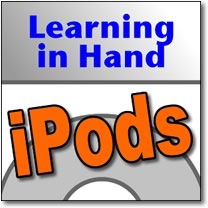Things to Know about Apps & Apple Devices
 Sunday, February 6, 2011 at 12:06AM
Sunday, February 6, 2011 at 12:06AM 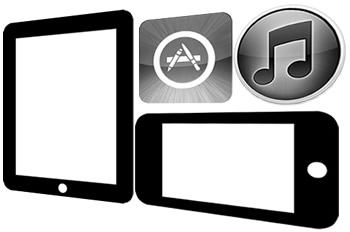 I've put together a list of things to know about iOS, apps, iTunes, and the App Store:
I've put together a list of things to know about iOS, apps, iTunes, and the App Store:
- Some software programs for Apple handhelds (known as "apps") come preinstalled on every device, including Safari for web browsing, Mail for email, and Notes for text files.
- You can download and install many more apps from the App Store. The App Store can be found in two places: in iTunes on Mac and Windows computers or in its own app on iPad, iPhone, and iPod touch.
- The App Store is organized in categories, including Games, Education, Photography, and Productivity.
- In addition to browsing categories, you can search the App Store. In iTunes you can perform a Power Search to filter results to free apps or a specific device. Alternatively, you can browse and search app at AppShopper.com. AppShopper's search results are more detailed than iTunes'.
- Approximately 34% of all apps are free of charge and another 31% are 99¢. The average price for an app is $2.50.
- You must have an iTunes account to download apps. For school sets of handhelds, it is recommended you create an account specifically for school. Typically Apple demands a credit card number to create an account. Follow these directions before creating an account and you won't be required to supply a credit card number.
- Each app downloaded is associated with an iTunes account.
- You can authorize up to five computers to use an iTunes account. An unlimited number of Apple handhelds can sync to a single computer.
- A single computer can have more than one account authorized on it. This is different than being signed in. Authorizing multiple accounts allows for installation of apps that may have been downloaded while signed into different accounts. Authorize accounts from iTunes' Store menu.
- Accounts authorized in iTunes are also authorized on the devices synced to that iTunes app Library.
- Syncing an individual device to the same computer each time is ideal. Attempting to sync to a different computer than the original can result in data loss and extreme frustration.
- You can sync multiple devices to one Mac or Windows computer simultaneously. There are options for carts, cases, and hubs to allow for connecting large numbers of devices to one computer.
- iPad can run almost all iPhone/iPod touch apps. iPhone and iPod touch cannot run iPad-specific apps. Universal apps can run on all three kinds of devices and are denoted in the App Store with a + symbol.
- Apps are updated periodically. Updates are free and often offer extra features and bug fixes.
- Some apps require the latest version of the iOS. You can check to see if your device is running the latest release of iOS by connecting it to iTunes, clicking the device's Summary Tab, and click the Check for Update button.
- Unlike music and movies, you can always re-download both free and paid apps from the App Store free of charge. Be sure you are signed into the iTunes account in which you originally bought the app.
- Free and paid apps purchased in the App Store app on the Apple handheld are copied to the iTunes Library upon the next sync.
- Periodically paid apps go on sale for free. For school sets of devices, be sure to document when apps are downloaded for free in case of a software audit.
- I often share apps you may be interested in on Twitter. Oftentimes the apps I share are temporarily on sale, so download them while they are free or cheap. twitter.com/tonyvincent
- Twitter users who reference an educational app frequently tag their tweets with #edapp. Searching Twitter for #edapp shows you these tweets all in one spot. Read more about #edapp.
- Apple has different Terms & Conditions for educational institutions relating to paid apps. Apple expects U.S. education customers to purchase a license for each device a paid app will be installed on using the App Store Volume Purchase Program.
- Apps can be organized into folders by tapping and holding one app until it jiggles. Then drop apps into existing folders or drop an app onto another to create a folder. Press the Home button when done.
- Folders and icon positions are individual to each device. Unless you restore a device from the backup of another device, folder and icon positions have to be manually set on each handheld.
- Deleting an app from the iTunes Library will also remove the app from any device which synchronizes with that library.
- Delete apps on the device by tapping an holding one app's icon until all icons begin to jiggle. Tap the X next to an app's icon to delete the app. Press the Home button when done.
- To prevent students from deleting apps, enable Restrictions and turn off Deleting Apps in the General section of the Settings app on each device.
- To prevent students from logging into their own accounts and installing apps, enable Restrictions and turn off Installing Apps in the General section of the Settings app on each device. However, this will need to be turned off and back on each time you want to legitimately install apps, even through iTunes.
- Double-tap the Home button to access a list of recently used applications and toggle among them.
- Got a lot of apps? Tap the Home button while on your first screen of apps to access a search field where you can enter an app's name to launch it.

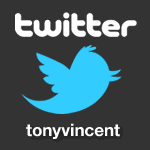



 An iTunes account is required to download iPhone/iPod touch applications from the App Store. When you create an account, iTunes asks you for a credit card number to keep on file for purchases. When using iPods in schools, teachers probably don't want to use their personal credit card and schools usually do not have a credit card that can be used for iTunes. Fortunately, there is a way to create a new iTunes account without giving financial information. Here's how:
An iTunes account is required to download iPhone/iPod touch applications from the App Store. When you create an account, iTunes asks you for a credit card number to keep on file for purchases. When using iPods in schools, teachers probably don't want to use their personal credit card and schools usually do not have a credit card that can be used for iTunes. Fortunately, there is a way to create a new iTunes account without giving financial information. Here's how:



 This is the first of many episodes of Learning in Hand: iPods that is video. More and more of what I will share on this show is visual,especially as the focus changes from click-wheel iPods to iPod touch and iPhone. By the way, I'm wearing these earbuds because they are the kind with a microphone--I tested recording video using a desktop mic and it just didn't sound as good--so I'm using these.
This is the first of many episodes of Learning in Hand: iPods that is video. More and more of what I will share on this show is visual,especially as the focus changes from click-wheel iPods to iPod touch and iPhone. By the way, I'm wearing these earbuds because they are the kind with a microphone--I tested recording video using a desktop mic and it just didn't sound as good--so I'm using these. With iTunes Link Maker, you search for the item in the iTunes Store to which you want to link. I type in Our City and choose Podcast as the Media Type. But as you can see, you can also link to other media types, like Music, Movies, TV Shows, Audio Books, Applications, and iTunes U.
With iTunes Link Maker, you search for the item in the iTunes Store to which you want to link. I type in Our City and choose Podcast as the Media Type. But as you can see, you can also link to other media types, like Music, Movies, TV Shows, Audio Books, Applications, and iTunes U.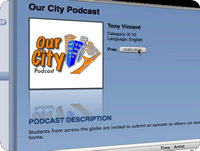 Go to the details page for what you'd like to link to. Right-click the Artwork and then choose Copy iTunes Store URL. Then you have that same URL you could have gotten from iTunes Link Maker. But, you can also use it to link to specific episodes. I can right-click a specific episode and copy the iTunes Store URL. Now, let me paste that URL into a Google Doc document just for demonstration purposes. Now when I click that link, not only does it open to the podcast page, but the specific episode I link to is highlighted.
Go to the details page for what you'd like to link to. Right-click the Artwork and then choose Copy iTunes Store URL. Then you have that same URL you could have gotten from iTunes Link Maker. But, you can also use it to link to specific episodes. I can right-click a specific episode and copy the iTunes Store URL. Now, let me paste that URL into a Google Doc document just for demonstration purposes. Now when I click that link, not only does it open to the podcast page, but the specific episode I link to is highlighted.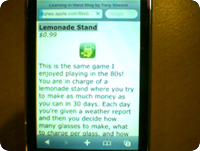 You can also link to search results. Let me show you how to do this for "math". On the results page, right-click See All in the Applications results and Copy the iTunes URL. When someone follows that URL, they are instantly taken to the iTunes search results that include Math and are in the App Store. Unfortunately, links to search results only works on desktop browsers and won't work on an iPod touch or iPhone. Also, links to iTunes U won't work on an iPod touch or iPhone because iTunes U does not yet appear in the mobile iTunes Store.
You can also link to search results. Let me show you how to do this for "math". On the results page, right-click See All in the Applications results and Copy the iTunes URL. When someone follows that URL, they are instantly taken to the iTunes search results that include Math and are in the App Store. Unfortunately, links to search results only works on desktop browsers and won't work on an iPod touch or iPhone. Also, links to iTunes U won't work on an iPod touch or iPhone because iTunes U does not yet appear in the mobile iTunes Store.